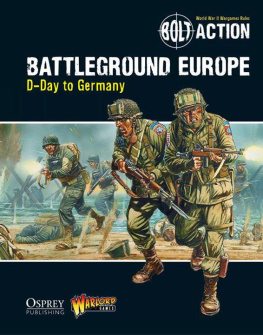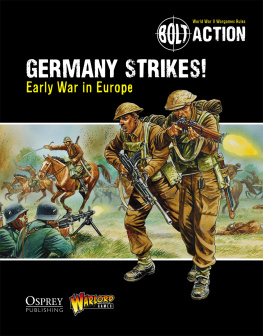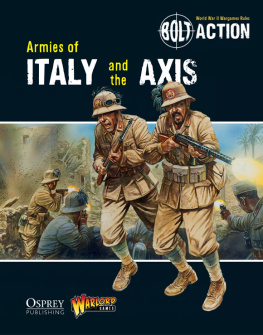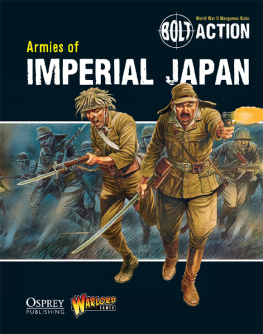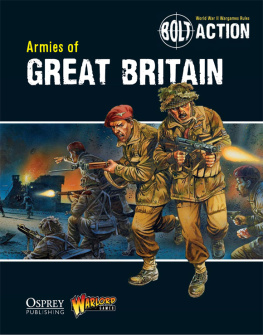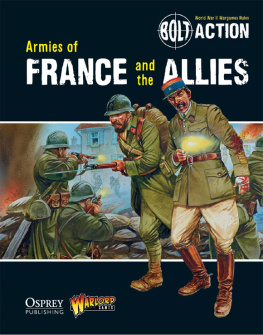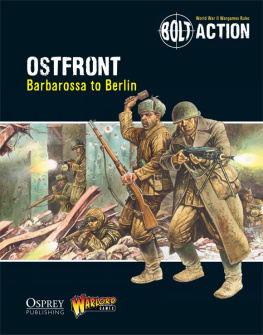CONTENTS
Make it count...
WHAT IS THIS BOOK?
Kampfgruppe Bhm races to the Meuse, by Peter Dennis Osprey Publishing Ltd. Taken from Campaign 145: Battle of the Bulge 1944 (2).
D-DAY TO BERLIN
T his Theatre Book is a supplement to the tabletop wargame Bolt Action. It deals with the final phase of World War II in Western Europe. We will begin during the build-up to the Invasion of Normandy, and follow the combatants through to the crumbling of the Third Reich and German surrender.
Our goal is to describe the context for games set within this phase of the war. What was it like to storm the beaches of Normandy? How formidable was the bocage country? What was it like to fight in the snowy woods of the Ardennes? By addressing these and many other questions, we can hope to enjoy more than just the game itself we can perhaps imagine a little of what those brave men went through.
This is not a definitive account of the campaign, nor is it meant to be. Think of it more as a tour through history, stopping at places of interest and pointing out pertinent information as we go. If you should strike upon an area that piques your interest, there are many resources available for you to explore in more detail. The military history of World War II makes for a fascinating study, and can prove to be quite a rabbit-hole if one allows it. Think of this book as your guide.
You will find several scenarios within these pages. Some depict actual historical battles, while others offer a view on typical operations that give a sense of what the fighting was like.
For the more historically minded reader, weve included details of various units that allow you to construct armies from specific time periods and areas of conflict. On the other hand, this book also allows for lots of what if battles to be fought out, using equipment that was on hand at the time.
Old Ironsides US 1st Armored Division rolls through occupied France
PRELUDE TO INVASION
Boston Mission - the 82nd Airborne over Drop Zone T, by Howard Gerrard Osprey Publishing Ltd. Taken from Campaign 104: D-Day 1944 (2).
Hitler held most of continental Europe in his grasp. The Allied invasion was never in doubt; it was only a question of when. Sooner or later, Hitlers Atlantic Wall would need to be breached and the Germans driven from France. The Invasion of Normandy would be the largest air, land and sea operation in the history of human conflict. Thankfully, that is a record that stands to this day.
PREPARATIONS
The scope of the operation was vast. It was a daunting task from the start, but the Allies were determined to pry Europe from Hitlers clutches and were willing to pay dearly for it.
Troops trained for up to two years before the actual invasion. Preparation was especially intense for airborne troops, who were using a deployment method that was scarcely tested at the time. Their contribution would provide critical support for the main landing, and as such the airborne divisions were made up of crack troops that had been vetted through a rigorous process of physical training.
In the months before the invasion, troops took part in simulated battles throughout sites in southern England. British, American and Canadian troops, as well as those from other Allied and occupied countries, invaded and re-invaded beaches identified as similar to the French beaches they would eventually storm.
There was also great care to insure the secrecy of the operation. The Germans were not completely unaware, of course. They knew an invasion of Europe was inevitable. However, the details of location, time, and method were still unknown. The Allies faced the challenge of orchestrating a massive troop movement without the Germans knowing exactly what was going on.
TIGER: THE CURSED EXERCISE
Training for D-Day was intense and relentless. At least five days a week the men were subjected to all manner of field problems and physical fitness exercises. With thousands of troops working in a relatively small area and using live fire training, accidents were bound to happen. One exercise in particular would be plagued with tragic mishaps: Exercise Tiger, the cursed exercise.
Slapton Sands near the southern tip of England was selected due to its striking resemblance to Utah beach most notably, its gravel sand and proximity to a lake. The residents were evacuated in 1943 to make room. Some had never before left their home village.
Tiger was set for the last week of April 1944, and focused on embarkation and a subsequent beach assault on Normandy. The troops would learn how to properly board their landing craft, as well as storming a beach while naval artillery rounds flew overhead. To this end, it was decided that the warships would use live ammunition in order to accustom the troops to sounds and smells of a naval barrage.
On the morning of 27 April, a live-fire shelling of the beach had been scheduled to end approximately half an hour before the troops were to land, giving the training officers time to make sure the beach was safe for training. Several of the landing boats ran late, so a decision was made to delay the landing by an hour, subsequently pushing the bombardment up as well. This message did not reach all of the boats, and as a result several boats landed at the previously agreed time, which unfortunately coincided with the new time that the bombardment was scheduled to begin. It also appears that some of the troops ignored (or at least, didnt see) safety measures that would have restricted their movements on the beach until the naval barrage had finished. When the dust cleared, over 300 troops lay dead.
The next day, a convoy of troop carriers was attacked by German E-boats in Lyme Bay. Over 600 more men would die as a result.
There were many mistakes that led to this tragedy. The convoy should have had two British ships to protect it, but due to a collision earlier in the exercise one was at Plymouth for repairs. Other British ships had spotted the E-boats, but failed to notify the convoy. The convoy was arranged in a straight line, making them an easier target. Perhaps the worst error was due to the simple fact that the American and British ships operated on different radio frequencies, making communication difficult if not impossible. The Americans had no idea they were sailing in enemy-infested waters with half the escort they were supposed to have.
For their part, the E-boats had found ill-defended targets and took advantage of the situation. They fired their torpedoes with deadly accuracy, setting two ships on fire and sinking one of them. Soldiers that had little to no experience in water often put their life vests on incorrectly, with fatal results.
The tragedy almost put an end to the invasion itself. Ten officers that were killed had high-level security clearances and knew about the impending invasion. If they had been captured, the plan would have been compromised, so it was put on hold until their bodies were eventually recovered.

